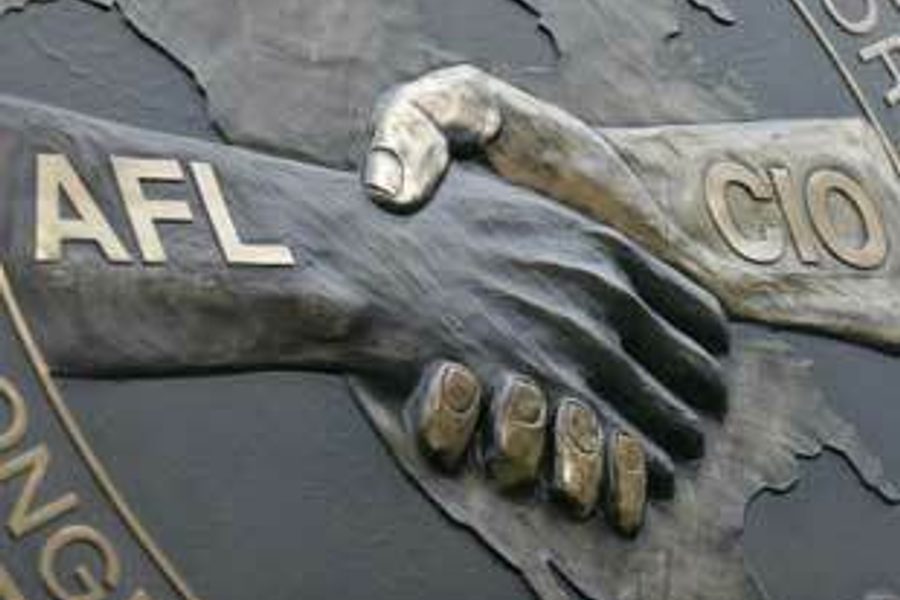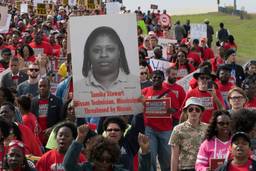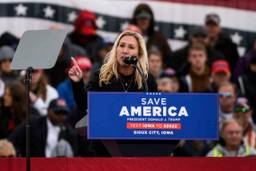Gods and Mortals
The AFL-CIO’s split may impact smaller state and local federations the most
David Moberg

Chicago – The decision by the Service Employees International Union (SEIU) and the Teamsters to leave the AFL-CIO-and the resultant loss of 2.6 million members and $18 million in dues-overshadowed the 50th anniversary convention of the AFL-in late July. Yet despite the potential impact of these large unions’ departure on national politics and the federation itself, one of the main repercussions of the split involves an oft-neglected, even little-known part of the labor movement: its state and local organizations.
These federations of labor and central labor councils (CLC), the rough equivalent of the AFL-CIO at state, municipal or regional levels, have often been sleepy bywaters of the labor movement. But starting even before John Sweeney was elected president of the AFL-CIO a decade ago, and accelerating under his regime, many of these CLCs and some of the state feds have grown much more active. They’ve become political powerhouses, important players in economic development, and centers for building real solidarity among local unions and their members across union lines.
Now, many of these groups will be hard-hit, not only losing much of their limited financing, but more importantly, disrupting their newly forged solidarity. “The immediate impact [of the split] will be felt by the state feds and the central labor councils,” said Pennsylvania AFL-CIO president Bill George. Raising his hands high above his head, he added, “The impact isn’t up here where the gods are fighting.”
The mere mortals of the labor movement were not only trying to figure out how to cope with the gods’ conflict, but were virtually reduced to reading chicken entrails to figure out what it all meant. The AFL-CIO constitution prohibits local-level memberships for unions that are not nationally affiliated with the AFL-CIO. The head of a small, 1,300-member CLC in North Worcester, Mass., Brian Sabourin said his local group would be virtually wiped out if the United Food and Commercial Workers-one member of the SEIU-led Change to Win Coalition-left the AFL-CIO.
Sabourin, a member of UFCW like six of the nine CLC board members, would have to quit his job as president. Many other state federation and CLC leaders are choosing to keep their local AFL-CIO posts and finding a new union to join, just as AFL-CIO president John Sweeney, former president of SEIU, recently joined the Office and Professional Employees to keep his job.
Sabourin was hoping against hope that the AFL-CIO would make it possible for him to keep his CLC job, “because that’s where all the action is,” and he didn’t approve of UFCW’s seemingly imminent decision to leave the AFL-CIO. Did he understand why it was happening? “No,” he said flatly. It was a common sentiment among CLC leaders. “It’s over my head,” said Connie Beissel, president of a small Minnesota CLC, of the split. “I do not understand it one bit.”
This is a reflection of the way the debate over the future of the labor movement has played out. “The worst thing about what’s happening is everything is from the top down, not the bottom up,” said Gene Davenport, a longshoreman and CLC board member from Stockton, Calif., who said that his CLC president, a member of SEIU, “was adamantly against what SEIU did.”
Murky gains
Also, even though Stern started the debate ostensibly about the direction of the labor movement and not its leadership, in the end the final division was over Change to Win unions’ demands for Sweeney to leave or, at the very least, make assurances that someone from their camp, not incumbent secretary-treasurer Richard Trumka, would be his successor. Although at one level the debate was about increased organizing, other than SEIU, several of the Change to Win unions have a spotty record in organizing and have not grown or have even lost members recently. At the same time, some remaining AFL-CIO unions have grown significantly (though many are neither organizing nor doing anything else very effectively).
And while Change to Win supporters sometimes posed the choice as one between politics and organizing, both sides argued that labor has to do both, and both agreed in principle that labor should be politically independent and bipartisan. But the details of debate on structural changes that the Change to Win unions saw as fundamental and that the AFL-CIO thought had been addressed through compromise proposals seemed beyond the grasp of even many union activists and leaders.
Solidarity is the watchword of the labor movement, and it was invoked repeatedly during the week, like a prayerful mantra to heal the rupture, as many union leaders from top to bottom of the labor movement attempted to minimize the break, retain ties, prevent open conflicts and keep alive the possibility of reuniting. “Our door should always be open,” Electrical Workers president Ed Hill told the convention. “My plea will always be for solidarity. There are no great principles dividing us.”
When SEIU and the Teamsters left, their presidents, Andy Stern and Jim Hoffa, offered to continue participation in the central labor councils and state federations. This may have been a genuine measure in part, but it was also a move that shifted the onus of breaking up those lower level bodies to Sweeney.
SEIU’s departure will be a big loss, especially on the west coast, because it was active in politically potent and innovative state and local organizations. But the pledge from the Teamsters rang hollow: Nationally, it has affiliated only about 11 percent of its membership to state federations, and its participation in CLCs is similarly low.
But for all of the expressions of concern about CLCs and state feds, the sorry fact is that only about half of the nation’s union membership have been dues-paying participants in these organizations. Only AFSCME, the Teachers, the Steelworkers, AFGE (federal employees), Communications Workers, and Painters are fully paid up.
In response to the deals and partnerships the disaffiliated unions wanted to arrange to stay in central labor councils, Sweeney told the convention, “This presents a direct challenge to the principles of unity and solidarity upon which our movement is built, and upon which it depends. They can’t have it both ways. We are one, integrated democratic labor movement, at the national, state and local level. We must reject the ‘free rider’ approach of the disaffiliated unions, who want to pick and choose the places where they affiliate and dictate the terms.”
But that’s precisely what unions have been doing all along with regard to the state and local organizations. At the same time, the Change to Win unions, which derided the voluntary nature of the AFL-CIO, were exploiting that voluntary nature by leaving, rather than staying in and fighting over the direction. Neither side has a monopoly on either good ideas or glaring contradictions.
State-level reshuffling
In the end, many CLCs in particular are going to do everything they can to abide by the letter of the AFL-CIO constitution but also by the spirit of solidarity, either through informal relationships, creation of new coalitions, or working through other public policy, political or campaign organizations.
“The form that it will take will be different in different places,” said John Goldstein, leader of the Milwaukee County Labor Council, which has long worked closely with unions, like the United Electrical Workers, outside of the AFL-CIO. The AFL-CIO is not likely to expend much energy making sure that the disaffiliated unions don’t participate, but some active unions-like AFSCME, CWA and the Teachers-may be the enforcers.
At one point, the AFL-CIO was considering giving the Executive Council “extraordinary powers” to suspend the constitution, “to address extraordinary circumstances arising from either disaffiliations from the AFL-CIO or from actions by affiliated or unaffiliated unions that impair the ability of the AFL-CIO to fulfill its objects and principles.” Although it was unclear what was intended, both Sweeney and Trumka implied that such powers might involve altering the constitution to permit disaffiliated unions to participate in local labor organizations. The proposal was ultimately dropped, partly because it sounded too much like George Bush’s Patriot Act or martial law, McEntee said.
But the Executive Council is still likely to consider a proposal that would allow locals of any unions that leave the AFL-CIO to participate in state and local labor bodies if they also directly affiliate with the AFL-CIO nationally by joining as a local. Once quite common, this option has usually been exercised only by locals that aren’t part of any national union.
In the end, part of a four-cent hike in the dues that unions pay the AFL-CIO will be funneled into a fund that will help hard-pressed federations and CLCs, and there will also be a renewed campaign to encourage all unions to fully pay into those organizations, a move that would solve most of their immediate financial crises.
Shoulder-to-shoulder
As Jeff Crosby, a CWA local president and president of a Massachusetts central labor council, argued, “Solidarity is a human relationship. We have to work together. It isn’t just a financial issue. I believe we can maintain a relation with our SEIU local that may have done more than any other in the CLC. I love those people. I’ll do whatever to maintain that relationship.” Still, he fears an outbreak of intra-union conflicts, like raiding each other for members, could rupture even those long-established ties.
So far, the AFL-CIO and the Change to Win unions remain more on a common path than the split would indicate. The convention adopted changes in AFL-CIO structure-creating the possibility of industry committees to guide organizing, providing rebates for organizing, establishing a new Executive Committee to guide the federation-that reflected Change to Win sentiments, even if they did not satisfy their demands. The AFL-CIO committed itself to a campaign to fight Wal-Mart, even though SEIU and the UFCW were the main unions potentially organizing those workers. Union leaders from both sides of the split signed a letter threatening to cut off funds to Democrats in the House who voted for the Central American Free Trade Agreement (CAFTA).
The federation also took what was a bold step on foreign policy, given its long history of identifying with whatever administration is in power on military and foreign policy issues. It passed a resolution strongly critical of the Bush administration for lying about Iraq, for its conduct of the war, for its failure to properly take care of both soldiers and veterans, and for its failure to protect rights of workers and unions in occupied Iraq. Most significantly, it called for the United States to withdraw from Iraq “rapidly,” which was taken by its proponents as the functional equivalent of “immediately.”
It will take many months, at least, to sort out the repercussions of the split, which could either stimulate both camps to work harder on both organizing and politics or degenerate into debilitating conflict. The central labor councils and state federations, long neglected during the years of unity, may now suffer most in times of division. But their leaders are going to try not only to survive, but to meet new benchmarks for performance that the federation set and, as Jesse Jackson urged the convention, to keep their “eyes on the real prize.”
As Cleveland Federation of Labor executive secretary John Ryan said, “We’re not going to let our internal strife stop our struggle for social justice.”

I hope you found this article important. Before you leave, I want to ask you to consider supporting our work with a donation. In These Times needs readers like you to help sustain our mission. We don’t depend on—or want—corporate advertising or deep-pocketed billionaires to fund our journalism. We’re supported by you, the reader, so we can focus on covering the issues that matter most to the progressive movement without fear or compromise.
Our work isn’t hidden behind a paywall because of people like you who support our journalism. We want to keep it that way. If you value the work we do and the movements we cover, please consider donating to In These Times.
David Moberg, a former senior editor of In These Times, was on staff with the magazine from when it began publishing in 1976 until his passing in July 2022. Before joining In These Times, he completed his work for a Ph.D. in anthropology at the University of Chicago and worked for Newsweek. He received fellowships from the John D. and Catherine T. MacArthur Foundation and the Nation Institute for research on the new global economy.







